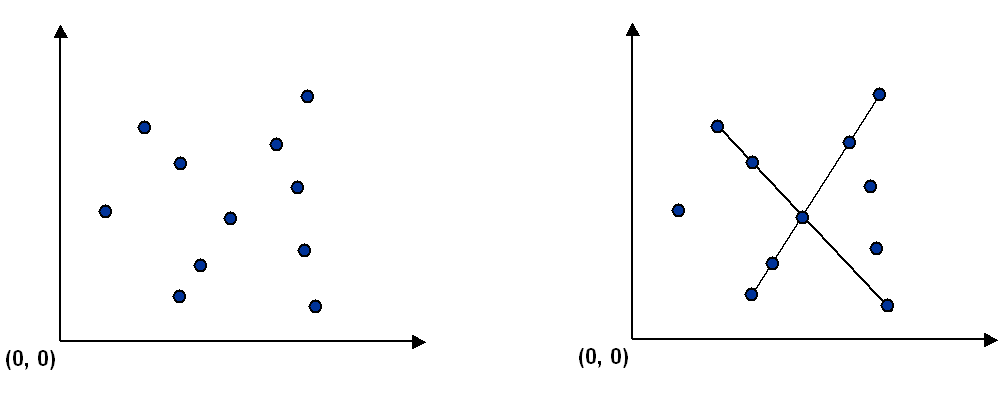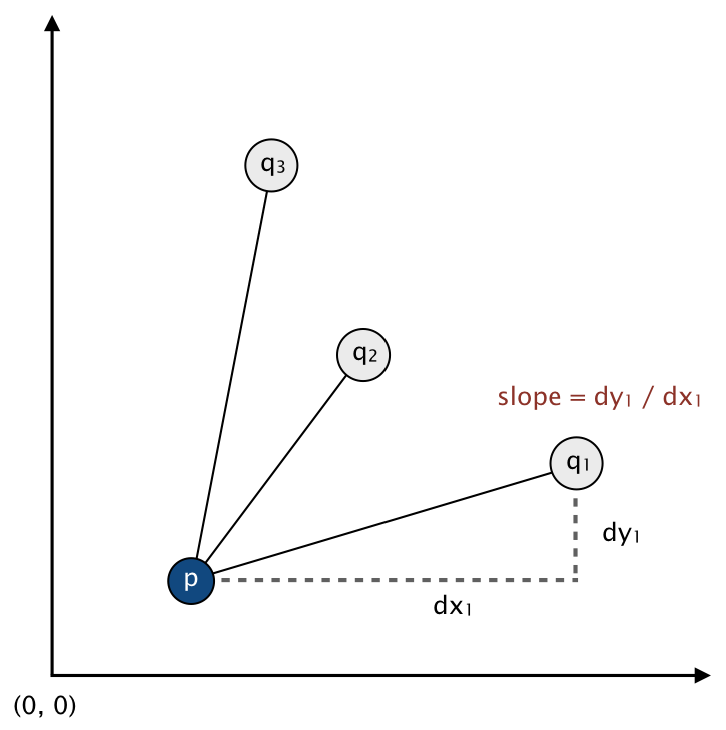 Collinear Points
Collinear Points
Computer vision involves analyzing patterns in visual images and reconstructing the real-world objects that produced them. The process is often broken up into two phases: feature detection and pattern recognition. Feature detection involves selecting important features of the image; pattern recognition involves discovering patterns in the features. We will investigate a particularly clean pattern recognition problem involving points and line segments. This kind of pattern recognition arises in many other applications such as statistical data analysis.
The problem. Given a set of n distinct points in the plane, find every (maximal) line segment that connects a subset of 4 or more of the points.

Point data type.
Create an immutable data type Point that represents a point in the plane
by implementing the following API:
public class Point implements Comparable<Point> {
public Point(int x, int y) // constructs the point (x, y)
public void draw() // draws this point
public void drawTo(Point that) // draws the line segment from this point to that point
public String toString() // string representation
public int compareTo(Point that) // compare two points by y-coordinates, breaking ties by x-coordinates
public double slopeTo(Point that) // the slope between this point and that point
public Comparator<Point> slopeOrder() // compare two points by slopes they make with this point
}
To get started, use the data type
Point.java,
which implements the constructor and the
draw(), drawTo(), and toString() methods.
Your job is to add the following components.
compareTo() method should compare points by their y-coordinates,
breaking ties by their x-coordinates.
Formally, the invoking point
(x0, y0)
is less than the argument point
(x1, y1)
if and only if either y0 < y1 or if
y0 = y1 and x0 < x1.
slopeTo() method should return the slope between the invoking point
(x0, y0) and the argument point
(x1, y1), which is given by the formula
(y1 − y0) / (x1 − x0).
Treat the slope of a horizontal line segment as positive zero;
treat the slope of a vertical line segment as positive infinity;
treat the slope of a degenerate line segment (between a point and itself) as negative infinity.
slopeOrder() method should return a comparator that compares its two argument
points by the slopes they make with the invoking point (x0, y0).
Formally, the point (x1, y1) is less than
the point (x2, y2) if and only if the slope
(y1 − y0) / (x1 − x0)
is less than the slope
(y2 − y0) / (x2 − x0).
Treat horizontal, vertical, and degenerate line segments as in the slopeTo() method.
equals() or hashCode() methods.
Corner cases. To avoid potential complications with integer overflow or floating-point precision,
you may assume that the constructor arguments x and y are each between 0 and 32,767.
Line segment data type. To represent line segments in the plane, use the data type LineSegment.java, which has the following API:
public class LineSegment {
public LineSegment(Point p, Point q) // constructs the line segment between points p and q
public void draw() // draws this line segment
public String toString() // string representation
}
Brute force.
Write a program BruteCollinearPoints.java that examines 4
points at a time and checks whether they all lie on the same line segment, returning all such line segments.
To check whether the 4 points p, q, r, and s are collinear,
check whether the three slopes between p and q,
between p and r, and between p and s
are all equal.
public class BruteCollinearPoints {
public BruteCollinearPoints(Point[] points) // finds all line segments containing 4 points
public int numberOfSegments() // the number of line segments
public LineSegment[] segments() // the line segments
}
The method segments() should include each line segment containing 4 points exactly once.
If 4 points appear on a line segment in the
order p→q→r→s,
then you should include either the line segment
p→s or s→p (but not both)
and you should not include subsegments such as p→r or
q→r.
For simplicity,
we will not supply any input to BruteCollinearPoints that has 5 or more collinear points.
Corner cases.
Throw an IllegalArgumentException if the argument to the constructor
is null, if any point in the array is null, or if
the argument to the constructor contains a repeated point.
Performance requirement. The order of growth of the running time of your program should be n4 in the worst case and it should use space proportional to n plus the number of line segments returned.
A faster, sorting-based solution. Remarkably, it is possible to solve the problem much faster than the brute-force solution described above. Given a point p, the following method determines whether p participates in a set of 4 or more collinear points.

Write a program FastCollinearPoints.java that implements this algorithm.
public class FastCollinearPoints {
public FastCollinearPoints(Point[] points) // finds all line segments containing 4 or more points
public int numberOfSegments() // the number of line segments
public LineSegment[] segments() // the line segments
}
The method segments() should include each maximal line segment
containing 4 (or more) points exactly once.
For example, if 5 points appear on a line segment in the
order p→q→r→s→t,
then do not include the subsegments p→s or q→t.
Corner cases.
Throw an IllegalArgumentException if the argument to the constructor
is null, if any point in the array is null, or
if the argument to the constructor contains a repeated point.
Performance requirement.
The order of growth of the running time of your program should be
n2 log n in the worst case and
it should use space proportional to n plus the number of line segments returned.
FastCollinearPoints should work properly even if the input has 5 or more collinear points.
Sample client. This client program takes the name of an input file as a command-line argument; read the input file (in the format specified below); prints to standard output the line segments that your program discovers, one per line; and draws to standard draw the line segments.
public static void main(String[] args) {
// read the n points from a file
In in = new In(args[0]);
int n = in.readInt();
Point[] points = new Point[n];
for (int i = 0; i < n; i++) {
int x = in.readInt();
int y = in.readInt();
points[i] = new Point(x, y);
}
// draw the points
StdDraw.enableDoubleBuffering();
StdDraw.setXscale(0, 32768);
StdDraw.setYscale(0, 32768);
for (Point p : points) {
p.draw();
}
StdDraw.show();
// print and draw the line segments
FastCollinearPoints collinear = new FastCollinearPoints(points);
for (LineSegment segment : collinear.segments()) {
StdOut.println(segment);
segment.draw();
}
StdDraw.show();
}
Input format. We supply several sample input files (suitable for use with the test client above) in the following format: An integer n, followed by n pairs of integers (x, y), each between 0 and 32,767. Below are two examples.
% cat input6.txt % cat input8.txt
6 8
19000 10000 10000 0
18000 10000 0 10000
32000 10000 3000 7000
21000 10000 7000 3000
1234 5678 20000 21000
14000 10000 3000 4000
14000 15000
6000 7000
% java-algs4 BruteCollinearPoints input8.txt (10000, 0) -> (0, 10000) (3000, 4000) -> (20000, 21000) % java-algs4 FastCollinearPoints input8.txt (3000, 4000) -> (20000, 21000) (0, 10000) -> (10000, 0) % java-algs4 FastCollinearPoints input6.txt (14000, 10000) -> (32000, 10000)
Web submission.
Submit a .zip file containing only
BruteCollinearPoints.java, FastCollinearPoints.java, and Point.java.
We will supply LineSegment.java and algs4.jar.
You may not call any library functions except those in
java.lang, java.util, and algs4.jar.
You may use library functions in java.util only if they have already
been introduced in the course. For example, you may use
Arrays.sort(), but not java.util.HashSet.